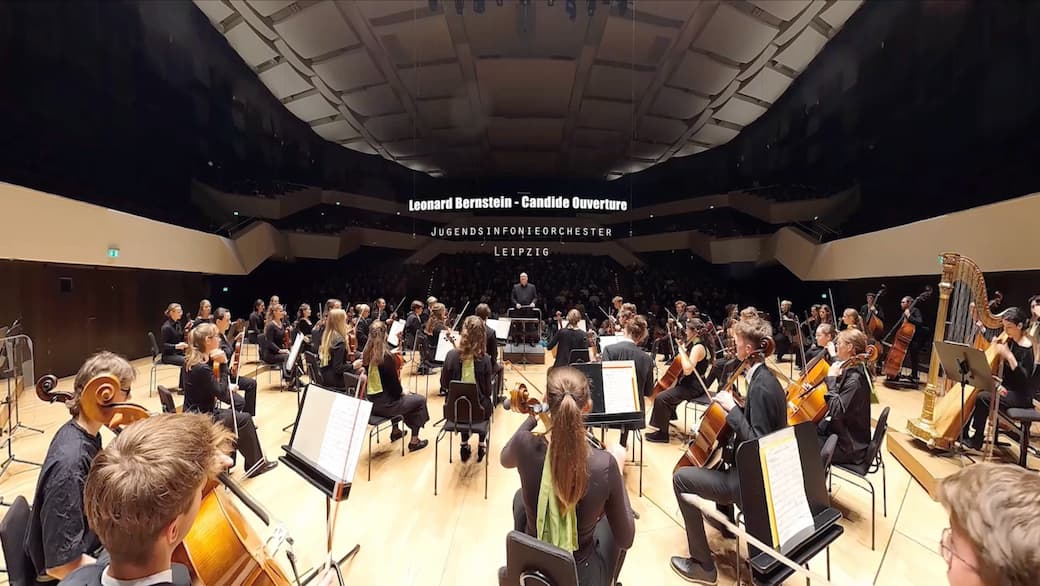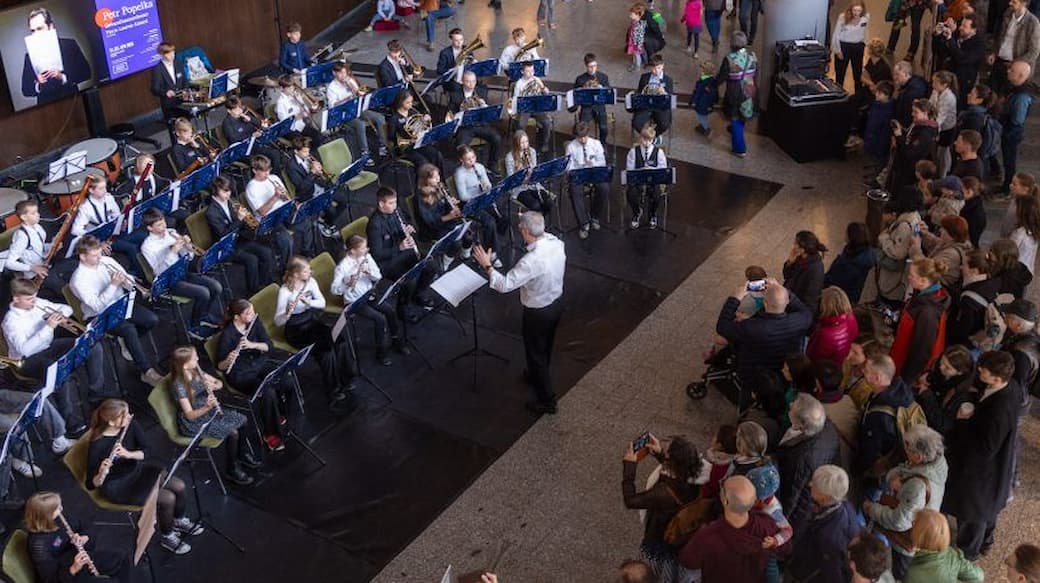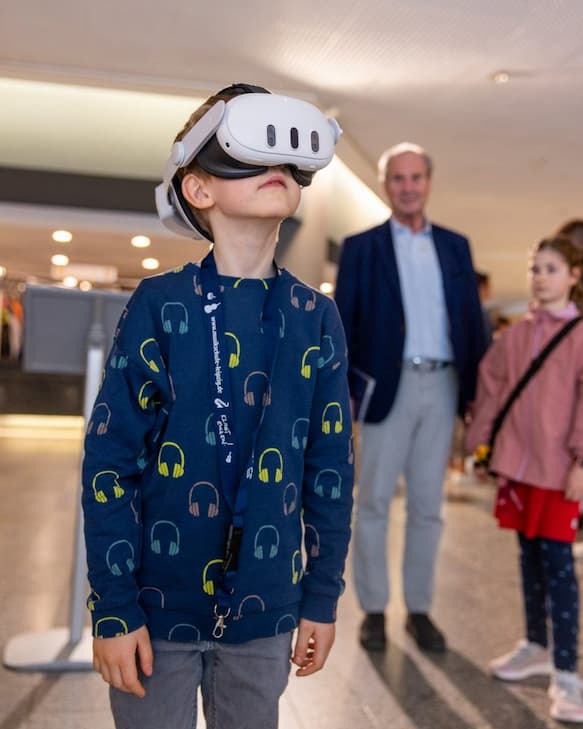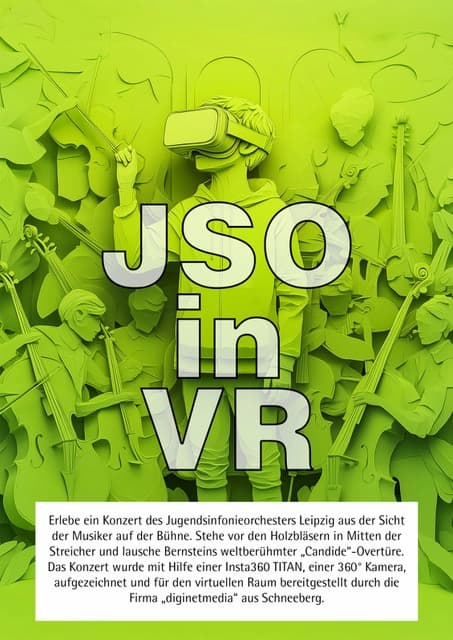
Inside an orchestra VR experience with spatial audio
On April 13, 2025, the Leipzig Gewandhaus was once again transformed into a lively venue for musical encounters. Located in the heart of Leipzig, the Gewandhaus is a central meeting place for music lovers. At the “Music Festival for All,” the Leipzig Music School “Johann Sebastian Bach” and the Leipzig District Music and Art School invited guests to an event and cultural highlight that presented the diversity of the music scene with an impressive show.
The musical offerings formed an extensive collection, allowing visitors to experience various instruments, sounds, instrumental ensembles, strings, concert grand pianos, songs, and pop and rock elements. Individual requests and program preferences of the guests were taken into account, so that everyone’s personal desire for musical diversity was fulfilled. The audience, fans, people of all ages, players, and music enthusiasts were invited to actively participate, play, or simply enjoy the music.
The special atmosphere, unique concert experience, and varied entertainment made for an unforgettable performance and captured the attention of everyone present. Various concert formats and events provided a platform for performances by artists, musicians, and conductors, who enriched the program with their performances. Technological developments opened up new dimensions, expanded the boundaries of the musical experience, and made the project an innovative highlight in the context of the current VR boom—with more opportunities to experience everything that the digital and real worlds have to offer.
The VR experience was developed through collaboration and innovation, bringing together advanced technology and creative vision. Economic and organizational aspects such as budget, business, production, products, product diversity, production, FAQs, framework conditions, camera use, film, and the participation of film composers were also professionally implemented. With VR glasses and other devices such as headsets, visitors were able to experience the orchestra from the perspective of a conductor through targeted instructions and interaction, with a high level of visual and auditory detail that enhanced the realism.
The immersive concert experience made visitors feel as if they were in the best seat in the house or even on stage with the orchestra members, creating a sense of intimacy and presence. Additionally, supplementary features such as tutorials, interactive elements, and unlockable content were offered to further enrich the event.
From 10 a.m. to 4 p.m., visitors of all ages were able to experience the diversity of musical offerings free of charge – from classical concerts to dance and family courses.
Among the hundreds of participating students and performances from a wide variety of genres, one premiere stood out this year: a concert from the orchestra’s perspective – made possible by virtual reality and the active involvement of orchestra members.
New for 2025: Experience an orchestra up close in VR – in 360 degrees.

A concert from the orchestra’s perspective in VR
For the first time, guests were able to enjoy the feeling of sitting in the middle of a symphony orchestra themselves. With VR glasses on their heads and a headset, the technology transported visitors directly onto the stage of the Great Hall. The 360-degree recording gave the impression of playing as a musician in the orchestra, with an impressive level of detail in both visuals and spatial audio. Instead of just listening from the outside, the 360-degree experience offered the musicians’ perspective: instruments up close, interaction with each other, and the full richness of sound – like a seat in the middle of the ensemble.
This virtual reality concert impressively demonstrated how immersive technologies can expand the scope of music education. As part of the interactive experience, visitors could conduct or direct the virtual orchestra, giving musical direction by manipulating tempo, giving cues, and moving their hands in the direction of arrows to control the performance. The ability to follow the score guided the performance, helping users understand the structure and cues necessary for a realistic orchestral experience. Particularly impressive was the variety of instruments, including strings, concert grand pianos, and other instrument sections, whose realistic sounds won over the audience. The concert experience opened up a whole new dimension, with the symphony orchestra’s performance and the immersive experience taking center stage. This virtual orchestra, as a digital and immersive musical project, showcased innovative ways to engage audiences and bring orchestral music to new spaces. It also became clear that, as exciting as the digital world is, nothing can replace the unique atmosphere of a real live concert in the traditional Gewandhaus. VR and reality complement each other rather than excluding each other.
Why virtual reality and 360 degrees in the concert hall?
The integration of VR and immersive 3D audio has a clear goal: authenticity. Only when sound sources and space are captured in high quality can a credible 360-degree sound experience be created. In developing this immersive VR experience, collaboration with a leading university has enabled advanced research and innovation, ensuring the latest academic insights are integrated into the project.
In addition, the expansion of boundaries and the current boom in VR technology are leading to more and more innovative projects being implemented within flexible budgets and clear framework conditions. FAQ sections provide answers to all important questions, while the extensive experience and collective expertise of those involved ensure maximum attention and a holistic experience.
Ambisonics, on the other hand, can be used to create realistic, spatial sound—perfect for concert experiences, games, gaming, or virtual reality film projects, where these technologies help build truly immersive environments.

Technical implementation of the VR orchestra experience
To prepare the concert for VR, several microphones and other devices, such as VR headsets and interactive equipment, were used to record individual instrument groups. The setup was supplemented by a central 360-degree microphone, which was placed in the middle of the orchestra and served as the Ambisonics base.
In Reaper, the individual tracks were then transferred to the Ambisonics space and converted to a uniform format. Each microphone is then digitally moved to the position in the room where it actually stood. An important part of the workflow was the integration of a reverb channel that combined the dry individual recordings with the room recording of the Zoom H2n. This “acoustic binder” ensured that the mix was perceived as a coherent 360-degree sound experience. The result: an immersive 3D mix that transports listeners right into the heart of the action – with a high level of detail in both sound and spatial experience, making it realistic, detailed, and emotionally captivating.
Two versions of the project are available on YouTube: a VR 360° recording, offering an immersive visual perspective, and a 3D audio version, made possible only by the brand-new Eclipsa audio plugins. This format enables flexible playback on almost any setup – from headphones with HRTF-based spatial audio to advanced 7.1.4 surround systems. While VR delivers the visual immersion inside the orchestra, Eclipsa ensures maximum acoustic precision and makes immersive listening accessible to everyone.
Orchester in VR: https://youtu.be/cA7zsYXuVCM
Orchester in 3D-Audio: https://youtu.be/Rx_nD9iftyU
Conclusion: Leipzig relies on virtual reality in music education
The “Music Festival for All” 2025 at the Gewandhaus Leipzig showed how virtual reality, 360-degree technologies, and 3D audio can revolutionize classical music education. Visitors were not only able to listen, but also become part of the orchestra themselves in VR. The rapid development of digital technologies is opening up a whole new dimension of the concert experience, in which the boundaries of what is possible are constantly being pushed and innovative experiences are being created for all music lovers. Virtual concerts are becoming a new way for audiences to experience music remotely, allowing participation in live or recorded events from anywhere in the world.
Leipzig thus combines tradition and innovation: the magic of a real live concert remains irreplaceable, but immersive VR experiences and the unique value of live performance in both real and virtual settings open up new ways to experience music in a deeper, more personal way. As part of this project, the wishes of the people, artists, musicians, and fans were taken into account to create new worlds of experience that offer show character, maximum attention, a rousing atmosphere, and the best entertainment. The ongoing innovation in music education is also reflected in the release of new digital experiences and projects, further expanding access and engagement.
